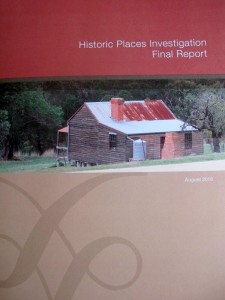Last Friday [September 9], the Victorian Environmental Assessment Council held a briefing session in Chewton on its Historic Places Investigation report.
At the end of the briefing, this question came from an audience member:
‘If the Government accepts and implements every recommendation in your report, what difference will it make to the running of the Castlemaine Diggings National Heritage Park?’
There was a silence, after which the VEAC presenter said: ‘While I think about that, I’ll tell you what difference it would make to the Mildura Hospital.’
This non answer was quite eloquent: it made clear that VEAC had failed to face the challenge of how to deal with heritage landscapes, as opposed to particular buildings, ruins or monuments.
A follow up question, ‘Has VEAC squibbed the problem of dealing with landscapes, which contain both natural and cultural features?’ was answered as follows: ‘No: the Council has just decided to deal as a priority with the more manageable problems, which are already hard enough.’
The investigation Report, which can be found here, contains many interesting proposals on how to deal with historic places under threat from many sources. It’s a great pity the Report failed to confront the landscape question. Historic landscapes face the same problems as historic buildings: neglect, inappropriate use leading to damage, development threats. In addition, these landscapes have peculiar challenges, in which heritage and natural values can be seen to be in conflict. The problem of horses and cattle in the Alps is one example; and irresponsible prospecting in the Diggings Park is another.
Two major themes in the report—on transparency and resourcing—are worth considering, even if they’re not new to anyone interested in the administration of public land: but on landscapes, apart from a few passing references, the Report makes only one statement, which readers can judge on its merits:
‘Recent trends in heritage appreciation have focused on movable heritage objects, shipwrecks, cultural landscapes and streetscapes. Recognition of cultural landscape and streetscape allows cultural significance to be considered as part of a broader context. In so doing, the range of stakeholders and landowners engaged is expanded and in many cases there will be a strong focus on private land. In February 2015 Heritage Council of Victoria and Heritage Victoria endorsed Landscapes of cultural heritage significance: assessment guidelines to support identification, documentation and assessment of landscape values. This document is to be used in conjunction with The Victorian Heritage Register criteria and threshold guidelines: assessing the cultural heritage significance of places and objects for possible state heritage listing, endorsed by the Heritage Council of Victoria in December 2012. Castlemaine Diggings is an unusual example of a cultural landscape in that it is largely located on public land, protected within Castlemaine Diggings National Heritage Park and listed on both state and national heritage registers or lists. In general, this emerging trend is less applicable to public land, with the exceptions of historic government building precincts or clusters of government facilities.’
The Report is now with the State Government, which will respond to the recommendations next year.





 Click on image for info/order page
Click on image for info/order page Click on image for info/order page
Click on image for info/order page Click on image for info/order page
Click on image for info/order page




















